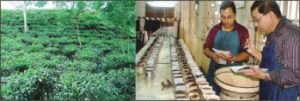Excessive rains bring worry for tea producers
Source: The Daily Star
Date: Aug 22, 2007
Although production of tea is likely to fall short of the target this season, gardeners and traders may feel encouraged by the continued rise of tea consumption, demand and sale in the market.
Heavy rainfall coupled with flooding in Moulvibazar, Sylhet and Habiganj, where 90 percent of tea gardens are located, has caused some concern among the gardeners and traders. They, however, believe that increase in local consumption and the vibrant transactions at the international weekly auctions here are still a good sign for Bangladesh tea.
In addition to this positive scenario in the domestic market, what we need most now is to upgrade the quality and quantity of tea to sustain in the competitive global market, they said. They also gave emphasis on the increase in the hectare-wise tea production by planting high-yielding saplings for better quality and competitive edge in future.
Although the negative impact of excessive rainfall will not take place right now, it is likely to be seen at the end of the season that ultimately will hamper the production target of the year, the traders said. Both sunlight and rain are required for better production of tea and any fluctuation of either component may wreak havoc such as outbreak of disease and pest attack (red spider or mosquito bug) in the sector, they said.
Bangladesh is still lagging far behind in hectare-wise production of tea, compared to major tea producing and exporting countries like Sri Lanka, India and Kenya, said MA Taher, vice-chairman of Tea Traders Association of Bangladesh (TTAB).He said the gardens on an average produce 1200 to 1250 kgs of tea per hectare, some a maximum of 2000 kgs and a few selective ones 2500 kgs and more. On the other hand, the tea production per hectare ranges between 3000 to 3500 kgs or more in Sri Lanka, India and Kenya, he added.
Due to lack of a good management, Taher said, new plantation of high-yielding saplings replacing the old ones has not been taking place and in the absence of proper initiative, many hills in Sylhet, Chittagong and other regions that are suitable for tea cultivation remain underutilized.
Meanwhile, tea has continued to witness a good market as far as price, demand, selling and consumption are concerned this season (2007-2008). Fifteen weekly international tea auctions, out of 45, of the season were held until August 14 and market feedback was satisfactory. On an average, about 80 to 85 percent of tea on offer in the auctions were sold, sources said.
“Up to sale No. 15 this season, about 1.60 crore kgs of tea were sold with an average price of Tk 82.86 per kg,” said Arif Rahman Shahin, senior executive of Purba Bangla Tea Brokers Ltd.
“Around 1.31 crore kgs of tea were sold during the corresponding period of the season 2006-2007,” he added.
According to the data available at Bangladesh Tea Association, tea production estimated up to July-end this year was about 2.33 crore kgs compared to 1.96 crore kgs during the same period last year.
Around 55 to 56 million kgs of tea are produced in 162 tea gardens (152 in production) in the country a year, sources said. Of this, local consumption is nearly 45 to 48 million kgs while the rest is exported.
The annual tea production in Bangladesh has unfortunately been static for many years — between 55 and 56 million kgs — barring the exception in 2005 when the figure rose to a record of 60 million kgs.









